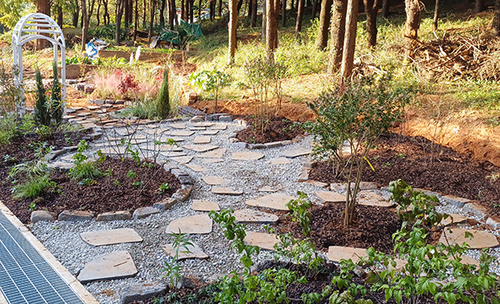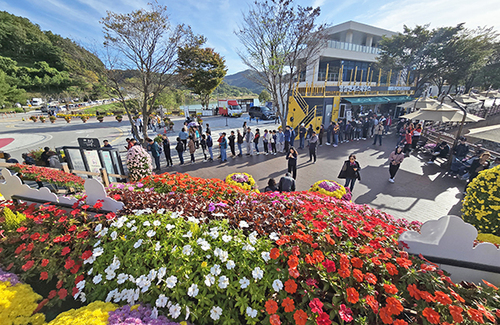| в–І м „л¶Ғ к№Җм ңмӢңк°Җ мӮ¬нҡҢм Ғ кұ°лҰ¬л‘җкё° н•ҙм ңлЎң көӯлӮҙ м—¬н–үмқ„ м„ нҳён•ҳлҠ” нҳ„мғҒмқҙ лҡңл ·н•ң кҙҖкҙ‘ мҲҳмҡ”м—җ лҢҖмқ‘н•ҳкё° мң„н•ҙ мҳӨлҠ” 16мқјл¶Җн„° мІңл…„кі м°°мқё кёҲмӮ°мӮ¬мҷҖ лІҪкіЁм ң л“ұ м§Җм—ӯ лҢҖн‘ң кҙҖкҙ‘м§ҖлҘј мүҪкі нҺёлҰ¬н•ҳкІҢ л‘ҳлҹ¬ліј мҲҳ мһҲлҠ” 'мӢңнӢ° нҲ¬м–ҙлІ„мҠӨ'лҘј мҡҙн–үмқ„ мһ¬к°ңн•ңлӢӨ. (кёҲмӮ°мӮ¬ м„ӨкІҪ) / мӮ¬м§„м ңкіө = к№Җм ңмӢңмІӯ © к№Җк°ҖмҳҒ кё°мһҗ |
|
мӮ¬нҡҢм Ғ кұ°лҰ¬л‘җкё° н•ҙм ңлЎң көӯлӮҙ м—¬н–үмқ„ м„ нҳён•ҳлҠ” нҳ„мғҒмқҙ лҡңл ·н•ң кҙҖкҙ‘ мҲҳмҡ”м—җ лҢҖмқ‘н•ҳкё° мң„н•ҙ 'мӢңнӢ° нҲ¬м–ҙлІ„мҠӨ' мҡҙн–үмқҙ мһ¬к°ңлҗңлӢӨ.
м „л¶Ғ к№Җм ңмӢңлҠ” "кі„л¬ҳл…„ мғҲн•ҙлҘј л§һм•„ мҳӨлҠ” 16мқјл¶Җн„° мІңл…„кі м°°мқё кёҲмӮ°мӮ¬мҷҖ лІҪкіЁм ң л“ұ м§Җм—ӯ лҢҖн‘ң кҙҖкҙ‘м§ҖлҘј мүҪкі нҺёлҰ¬н•ҳкІҢ л‘ҳлҹ¬ліј мҲҳ мһҲлҠ” 'мӢңнӢ° нҲ¬м–ҙлІ„мҠӨ'лҘј мҡҙн–үн•ңлӢӨ"кі 13мқј л°қнҳ”лӢӨ.
мҙқ 140нҡҢ к°Җлҹү мҡҙн–үн• кі„нҡҚмқё 'мӢңнӢ° нҲ¬м–ҙлІ„мҠӨ'лҠ” лҢҖн‘ң кҙҖкҙ‘м§ҖлЎң кө¬м„ұлҗң м •к·ңмҪ”мҠӨ л°Ҹ кі„м Ҳлі„лЎң к°Җліјл§Ңн•ң кҙҖкҙ‘м§ҖлҘј м—°кі„н•ң н…Ңл§ҲмҪ”мҠӨлЎң кө¬м„ұлҗңлӢӨ.
нҠ№нһҲ в–І м—ӯмӮ¬ л¬ёнҷ”мҪ”мҠӨ = к№Җм ң лҸҷн—ҢгҶҚлӮҙм•„гҶҚн–ҘкөҗгҶҚл§ҢкІҪлҠҘм ңгҶҚл§қн•ҙмӮ¬ в–І лҶҚкІҪ л¬ёнҷ”мҪ”мҠӨ = кёҲмӮ°мӮ¬гҶҚлІҪкіЁм ңгҶҚм•„лҰ¬лһ‘л¬ён•ҷкҙҖ в–І мғҲл§ҢкёҲ мҪ”мҠӨ л“ұ 3к°ң мҪ”мҠӨлЎң мҡҙмҳҒн• кі„нҡҚмқҙлӢӨ.
20лӘ… мқҙмғҒ лӢЁмІҙмқҳ кІҪмҡ° нғ‘мҠ№мҪ”мҠӨлҘј мЎ°м •н• мҲҳ мһҲлҠ” л§һм¶Өнҳ• мҪ”мҠӨлҸ„ мҡҙмҳҒн•ңлӢӨ.
мҳӨлҠ” 16мқјл¶Җн„° 2мӣ” л§җк№Ңм§Җ мҳҲм•Ҫмһҗм—җ н•ңн•ҙ мҶҢм •мқҳ кё°л…җн’ҲлҸ„ лҚӨмңјлЎң м ңкіөн• кі„нҡҚмқҙлӢӨ.
к№Җм ңмӢң мҶЎм„ұмҡ© л¬ёнҷ”нҷҚліҙ축м ңмӢӨмһҘмқҖ "мӢңнӢ° нҲ¬м–ҙлІ„мҠӨлҠ” мҲҳмқө л…ём„ мқҙ м•„лӢҲлқј м§Җм—ӯмқ„ м°ҫмқҖ кҙҖкҙ‘к°қл“Өмқҳ нҺёмқҳлҘј лҶ’мқҙлҠ” лҸҷмӢңм—җ м§Җм—ӯкІҪм ң нҷңм„ұнҷ”м—җ мӨ‘м җмқ„ л‘җкі мҡҙмҳҒн•ҳкі мһҲлӢӨ"л©° "мӢңнӢ° нҲ¬м–ҙлІ„мҠӨлҘј мқҙмҡ©н•ҳл©ҙ к№Җм ңл§Ңмқҳ мҲЁмқҖ л§Өл Ҙмқ„ к°ҖмһҘ м Җл ҙн•ҳл©ҙм„ңлҸ„ нҺён•ҳкІҢ мҰҗкёё мҲҳ мһҲлҠ” мһҘм җмқҙ мһҲлӢӨ"кі м„ӨлӘ…н–ҲлӢӨ.
мқҙм–ҙ "лҲҲмңјлЎңл§Ң мҰҗкё°лҠ” кҙҖкҙ‘мқҙ м•„лӢҲлқј мң мқөн•ҳкі м•Ңм°¬ кҙҖкҙ‘мқ„ мҰҗкёё мҲҳ мһҲлҸ„лЎқ л¬ёнҷ”кҙҖкҙ‘н•ҙм„ӨмӮ¬к°Җ лҸҷн–үн•ҙ к№Җм ңмқҳ м—ӯмӮ¬гҶҚл¬ёнҷ” н•ҙм„ӨмқҖ л¬јлЎ кҙҖкҙ‘м§Җлі„ мҲЁкІЁм§„ мқҙм•јкё°лҘј нқҘлҜёлЎӯкІҢ м „н•ҙмЈјкі мһҲлӢӨ"л©° "л§ҺмқҖ кҙҖкҙ‘к°қмқҙ к№Җм ң м—¬н–үмқҳ л§Өл Ҙмқ„ л§ҲмқҢк»Ҹ лҲ„лҰҙ мҲҳ мһҲлҸ„лЎқ н”„лЎңк·ёлһЁ мҡҙмҳҒм—җ мөңм„ мқ„ лӢӨн•ҳкІ лӢӨ"кі лҚ§л¶ҷмҳҖлӢӨ.
н•ңнҺё, 5лӘ… мқҙмғҒ мӮ¬м „ мҳҲм•Ҫн• кІҪмҡ° л§Өмқј м¶ңл°ңн•ҳлҠ” 'к№Җм ң мӢңнӢ°нҲ¬м–ҙлІ„мҠӨ'лҠ” м§ҖлӮңн•ҙ 1мқёлӢ№ 4,000мӣҗмқҳ мҡ”кёҲмңјлЎң мҙқ 143нҡҢгҶҚ2,486лӘ…мқҙ мқҙмҡ©н•ң кІғмңјлЎң 집계лҗҗлӢӨ.
мІңл…„кі м°°мқё 'кёҲмӮ°мӮ¬'лҠ” л°ұм ң 599л…„(л°ұм ң лІ•мҷ•)м—җ мҷ•мқҳ мһҗліө мӮ¬м°°лЎң кұҙлҰҪлҗҗмңјл©° мӢ лқјнҶөмқј мқҙнӣ„ нҳңкіөмҷ•(766л…„) л•Ң к№Җм ңм¶ңмӢ мқё 진н‘ңмңЁмӮ¬м—җ мқҳн•ҙ мӨ‘м°Ҫлҗҳл©ҙм„ң м Ҳмқҳ кё°нӢҖмқ„ 갖추기 мӢңмһ‘н–ҲлӢӨ.
мӨ‘м°Ҫ мқҙнӣ„ мҲҳн–үкіј нҸ¬көҗм—җ м „л…җн•ң 진н‘ңмңЁмӮ¬лҠ” лҜёлҘөмӢ м•ҷмқ„ мӨ‘мӢ¬мңјлЎң көҗм„ёлҘј нҷ•мһҘмӢңмјң мӢ лқј 5көҗмқҳ н•ҳлӮҳмқё 'лІ•мғҒмў…'мқ„ м„ұлҰҪн•ҳлҠ”лҚ° нҒ° м—ӯн• мқ„ н–ҲлӢӨ.
кі л Ө л¬ёмў… л•Ң к°ҖмһҘ нҒ° к·ңлӘЁлҘј мқҙлӨҳм§Җл§Ң мЎ°м„ мӢңлҢҖ мһ„진мҷңлһҖмқ„ кұ°м№ҳл©ҙм„ң л§Һмқҙ мҶҢмӢӨлҗң кІғмңјлЎң м•Ңл Өм ё мһҲмңјл©° кі мў… л•Ң лҜёлҘөм „ л°Ҹ лҢҖм Ғкҙ‘м „ л“ұмқ„ ліҙмҲҳн–Ҳкі 1934л…„ лҢҖм Ғкҙ‘м „кіј кёҲк°•л¬ёмқ„ лӢӨмӢң мҲҳлҰ¬н–ҲлӢӨкі м „н•ҙ진лӢӨ.
мһ„진мҷңлһҖ лӢ№мӢң лҮҢл¬ө мІҳмҳҒлҢҖмӮ¬к°Җ 1,000м—¬лӘ…мқҳ мҠ№кө°мқ„ лӘЁм§‘н•ҙ м „кіөмқ„ м„ёмӣ лҚҳ нҳёкөӯлҸ„лҹүмқҙлӢӨ.
көӯліҙ м ң62нҳёмқё лҜёлҘөм „кіј кі л Ө м„қмЎ°кұҙ축물гҶҚмЎ°м„ нӣ„кё° лӘ©мЎ°кұҙ축물 л“ұ м—¬лҹ¬ ліҙл¬јмқ„ ліҙмң н•ҳкі мһҲлҠ” л“ұ нӣ„л°ұм ң кІ¬нӣӨмқҙ м•„л“Өм—җ мқҳн•ҙ мң нҸҗлҗң кіімңјлЎң мң лӘ…н•ҳлӢӨ.
вҳһ м•„лһҳлҠ” мң„ кё°мӮ¬лҘј кө¬кёҖ лІҲм—ӯмқҙ лІҲм—ӯн•ң мҳҒл¬ё кё°мӮ¬мқҳ 'м „л¬ё' мһ…лӢҲлӢӨ.
кө¬кёҖ лІҲм—ӯмқҖ мқҙн•ҙлҸ„лҘј лҶ’мқҙкё° мң„н•ҙ л…ёл Ҙн•ҳкі мһҲмңјл©° мҳҒл¬ё лІҲм—ӯм—җ мҳӨлҘҳк°Җ мһҲмқҢмқ„ м „м ңлЎң н•©лӢҲлӢӨ.
гҖҗBelow is the 'full text' of the English article translated by Google Translate.
Google Translate is working hard to improve understanding, and assumes that there are errors in the English translation.гҖ‘
Kim JessiвҖҰ Operation of 'City Tour Bus' from the 16th
3 courses, KRW 4,000 per person, departures every day with advance reservation for 5 people
Reporter Kim Ga-young
With the lifting of social distancing, the operation of the 'City Tour Bus' will be resumed to respond to tourism demand, which has a clear preference for domestic travel.
Gimje City, Jeollabuk-do announced on the 13th that "From the 16th, in celebration of the new year of the year of the cat, 'City Tour Bus' will be operated to easily and conveniently tour representative tourist attractions in the region, such as Geumsansa Temple and Byeokgolje Temple, a thousand-year-old temple."
The 'City Tour Bus', which is planned to operate a total of 140 times, consists of a regular course consisting of representative tourist destinations and a theme course linked to tourist attractions worth visiting by season.
In particular, в–І History and Culture Course = Gimje DongheonгҶҚNaeaгҶҚHyanggyoгҶҚMangyeongneungjeгҶҚManghaesa в–І Agricultural Culture Course = GeumsansaгҶҚByeokgoljeгҶҚArirang Literature Museum в–І Saemangeum Course will be operated as 3 courses.
For groups of 20 or more, a customized course is also operated to adjust the boarding course.
From the 16th to the end of February, a small souvenir will be provided as a bonus only for those who make a reservation.
Song Seong-yong, head of the cultural promotion and festival department in Kimje-si, said, "City tour buses are operated with an emphasis on revitalizing the local economy while enhancing the convenience of tourists visiting the region, not as a profit route." It has the advantage of being cheap and comfortable," he explained.
He continued, "In order to enjoy beneficial and fruitful tourism, not just sightseeing, a cultural tourism commentator accompanies Gimje's history and culture, as well as interesting stories about each tourist destination." We will do our best to operate the program so that you can enjoy it to the fullest."
On the other hand, the 'Gimje City Tour Bus', which departs every day for 5 or more people with advance reservations, was used by a total of 143 times and 2,486 people last year at a rate of 4,000 won per person.
'Geumsansa', a thousand-year-old temple, was built in Baekje 599 (King Baekje) as a temple for the king's self-confidence.
Master Jinpyo, who devoted himself to ascetic practices and propagation after the reconstruction, played a major role in establishing the 'Beopsang Order', one of the five religions of Silla, by expanding the church centering on Maitreya faith.
It was the largest during the reign of King Munjong of the Goryeo Dynasty, but is known to have been largely lost during the Imjin War during the Joseon Dynasty.
During the Japanese Invasion of Korea in 1592, Ambassador Noomuk Cheoyeong recruited about 1,000 monks and established a major as a patriotic sword.
It is famous as the place where Gyeon Hwon of Later Baekje was imprisoned by his son.




 м»Өл®ӨлӢҲнӢ°
м»Өл®ӨлӢҲнӢ°  н”јн”Ң
н”јн”Ң  лҸ…мһҗнҲ¬кі
лҸ…мһҗнҲ¬кі
















 л§Һмқҙ ліё лүҙмҠӨ
л§Һмқҙ ліё лүҙмҠӨ











